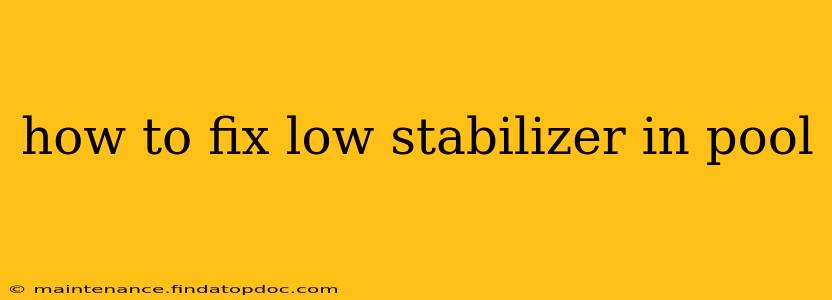Maintaining the proper chemical balance in your swimming pool is crucial for clear, sparkling water and a safe swimming environment. One vital component is stabilizer, also known as cyanuric acid (CYA). A low stabilizer level renders your chlorine ineffective, leading to algae growth and other water quality issues. This guide will explain how to fix a low pool stabilizer level, addressing common questions and concerns.
What is Pool Stabilizer (Cyanuric Acid)?
Pool stabilizer, or cyanuric acid (CYA), protects chlorine from being broken down by sunlight. Without sufficient stabilizer, the sun rapidly degrades chlorine, making it less effective at sanitizing the water. Think of it as sunscreen for your pool chlorine – it prolongs its lifespan and effectiveness. An optimal range is generally between 30-50 ppm (parts per million).
How Do I Test My Pool Stabilizer Level?
You'll need a reliable pool test kit to accurately measure your CYA level. Test strips are convenient, but a liquid test kit generally offers more precise results. Follow the instructions provided with your chosen test kit carefully. Regular testing is key to proactive pool maintenance.
Why is My Pool Stabilizer Low?
Several factors can contribute to low stabilizer levels:
- Backwashing: Backwashing your filter can remove some stabilizer.
- Rainfall: Heavy rainfall dilutes the chemicals in your pool, including stabilizer.
- Lack of Regular Testing and Treatment: Failing to regularly check and adjust chemical levels is the most common cause.
- Excessive Brushing/Vacuuming: Vigorous cleaning can sometimes disrupt the chemical balance.
How to Raise Pool Stabilizer Levels
Raising low pool stabilizer levels is straightforward. You'll need to add a cyanuric acid increaser, which is available at most pool supply stores.
Steps:
- Test your water: Accurately measure your current CYA level using a test kit.
- Calculate the amount needed: The product packaging will provide instructions on how much to add based on your pool's volume and the desired increase in CYA levels.
- Add the stabilizer: Slowly add the cyanuric acid increaser to the pool, preferably in an area with good circulation, such as near the return jets.
- Run the pump: Keep the pump running for at least 24 hours to ensure the stabilizer is evenly distributed throughout the pool.
- Retest: After 24 hours, retest your water to verify the CYA level has increased to the desired range (30-50 ppm).
How Often Should I Check and Adjust My Pool Stabilizer?
It's recommended to test your pool water, including the stabilizer level, at least once a week, especially during peak swimming season. Regular testing allows you to catch and correct imbalances before they become major problems.
What Happens If My Stabilizer Level is Too High?
While a low stabilizer level is problematic, an excessively high level (above 100 ppm) can also be detrimental. High CYA levels reduce the effectiveness of chlorine, requiring larger amounts of chlorine to achieve proper sanitation. This can lead to increased chemical costs and potential skin irritation. If your CYA level is too high, you may need to partially drain and refill your pool.
Can I use granular chlorine that contains cyanuric acid to increase my stabilizer?
Yes, you can use granular chlorine that contains cyanuric acid to help increase the stabilizer levels, but it's important to calculate the amount correctly to avoid overdoing it. The amount of stabilizer added through chlorine will be much lower than if you're adding it directly, so use the product packaging as a guide and test often!
Is it necessary to shock my pool after adding stabilizer?
Shocking your pool after adding stabilizer isn't strictly necessary, but it's good practice. Shocking helps to oxidize any organic contaminants that might be in the water, improving its overall clarity.
By following these steps and regularly testing your water, you can maintain the proper stabilizer level in your pool, ensuring clean, safe, and enjoyable swimming conditions. Remember to always consult the instructions on your chosen pool chemicals and test kits.
